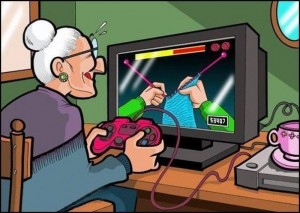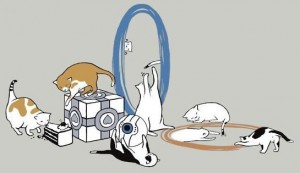Интерактивография – новый научный термин или Манифест любви к играм
(аналитическая статья, научно-популярная, манифест)
Тема статьи: Интерактивография – новый научный термин, обозначающий искусство электронно-цифровых игр.
Автор – Дмитрий Гервас (учёный-теоретик, геймдизайнер, писатель, графический дизайнер)
LinkedIn: http://lnkd.in/bcwr2GP
Facebook: https://www.facebook.com/ghervas.dt
Слово от автора:
Этот манифест был впервые опубликован в Интернете 16 октября 2013 года. С тех пор я его несколько раз существенно отредактировал, внеся также новые записи.
Прошу к моему труду относится с уважением. А свои негативные эмоции и несуразные мысли прошу держать при себе. 🙂
В этом манифесте написано о научном термине интерактивография, который представляет собою искусство электронно-цифровых игр (то есть, искусство видео игр).
Надеюсь что эта статья-манифест поможет вам лучше понять само искусство видео игр и её важность в современной эпохе.
Короткое введение:
Что же такое “Интерaктивография“, почему так называется и откуда такое название?
– Я, автор этого термина, будучи учёным-теоретиком и геймдизайнером, являюсь также большим поклонником игр и даже пытаюсь лично создавать кое-чего в этой сфере.
Когда я впервые ознакомился с термином “Интерактивное Искусство”, представляющая искусство игр, я понял что с таким, не совсем конкретным названием, было бы слишком мало и несправедливо по отношению к такой грандиозной форме современного искусства и обширной области культуры. Поэтому я поставил себе цель найти более адекватное и логичное название, с точки зрения науки. Будучи хорошо знакомым с этой областью, я проанализировал разные вариации, пока наконец дошёл до конкретного термина, который более бы корректно обозначал это искусство, начиная от её основы (-так сказать, от истоков) и способный приоткрыть изнутри данное явление – интерактивография.
На заметку: согласно многовековой традиции, научный термин должен быть составлен из латинских и греческих слов, что в общем-то я и сделал. 🙂
Формулировка:
Интерактивогрáфия (латынь: inter–между, activitas-деятельность, graphica-графика) – это форма синтетического искусства на базе компьютерной программы, составленная из графических изображений, либо движущиеся или неподвижные, в 2D или 3D измерении, в которой пользователь, с помощью определённого интерфейса и манипуляторов, может взаимодействовать с виртуальными объектами, тем самым участвуя лично в действиях, происходящие в играх.
Как известно, продуктом интерактивографического искусство является “Игра” (Game, Juego, Jeu etc.), а её пользователем называется “Игрок” (Gamer, Jucător, Joueur etc.).
 Детальнее:
Детальнее:
“Интерактивография”, названная также “интерактивным искусством”, известно как искусство в которой игрок обычно участвует в определённых симуляциях или в виртуальных интерактивных событиях, в которых имеет возможность, как виртуальный актёр, принимать участие в развитии художественного или документального сюжета игры. В некоторых играх пользователь может своими действиями приоткрывать их сюжет, даже развивать сюжет в своих интересах, имея при этом возможность повторять одно и то же действие по несколько раз. Ну а в некоторых современных играх пользователь может прийти к тому финалу, который будет зависеть от его личных действий на протяжении игры.
Говоря проще, в современной игре каждый игрок может принять участие в разных имитациях действий, вдохновлённые из реальной жизни или же поучаствовать в придуманных действиях, которые могут быть “облачены” каким-то сюжетом (художественный или нет) и где может почувствовать себя в коже виртуального персонажа, участвуя в событиях игры как очевидец или даже как настоящий актёр в главной роли. Это всё равно как играть в театре на какой-то сцене, не зная текста и сюжета, но зато постепенно узнаём всё лично, вмешиваемся когда захотим и даже можем менять финал в нашу пользу.
Соответственно, будучи синтетическим искусством (составным), интерактивографическое искусство похожа на театр, где мы сами играем как актёры, да ещё снимаемся на виртуальных киноплощадках. К тому же в играх можем и танцевать, петь, слушать музыку, строить как архитекторы, рисовать и т.д., любоваться прекрасным и высоким искусством или же просто дурачится и бродить. -))
Всё же Интерактивогрáфия предлагает нам намного больше возможностей, чем театр или кинематогрáфия, постоянно развивается и я даже позволю себе сказать что эта, относительно новая форма искусства, является сейчас наиболее важной для человечества, чем другая форма искусства! -)
 Краткая история, взаимосвязи:
Краткая история, взаимосвязи:
Поскольку интерактивография является синтетическим искусством (составным), оно также имеет много общих касательных связей (взаимосвязей) с определёнными формами искусства, в основном с кинематогрáфией.
К примеру, в первые десятилетия существования кинематографии, некоторые критики и деятели искусства утверждали что эта “новая” форма искусства является всего лишь слабой имитацией театра и на большее не будет способна. Но по мере развития технологий, в фильмах появились звуки и музыка, цвета, даже впечатление глубины (стерео-видение или так называемая 3D vision ) и возможно со временем появятся другие осязания, новые возможности и другие технические чудачества.
Сейчас если посмотрим на короткую историю игр, с первых полуцифровых игровых приставок (какими были Pong, Magnavox Odissey и т.д.) и до последних поколений приставок и современных персональных компьютеров, то мы можем наблюдать эволюцию интерактивографии в полном масштабе, которая ещё продолжается. Мы увидели появление не только звуков и цветов в играх, но и потрясающее развитие графики, а также разных манипуляторов для интерактивности. Но самое главное, мы увидели потрясающее развитие продуктов интерактивографии – игр – от простых чёрно-белых спортивных симуляторов, до целых художественных или документальных работ с миллионными бюджетами, с отдельными сюжетами как в фильмах и фотореалистичной графикой. Само собой, над интерактивографическим искусством нависла целая волна негативной критики со стороны тех кто её не понял и не взлюбили, но ведь понимаем что не такие критики останутся в истории, а лишь те кто понимают это искусство и обожают её. -)
Таким образом, развитие интерактивографии зависит много от научно-технического прогресса, в основном от цифровой компьютеризированной техники, которая предлагает нам не только мощные и более совершенные аппараты, но и новые возможности взаимодействия в виртуальных мирах.
К тому же, некоторые кинематографические методы широко применяются в играх, как например видео сцены снятые вживую (документальные или с актёрами) или же с помощью виртуальных съёмочных камер внутри самих игр – так называемые “кат-сцены” (cut-scene, cinematic sequences).
Интерактивографические жанры также идентичны жанрам кино и театра, даже если некоторым кажется что в играх больше жанров. На самом деле, “большое” число этих жанров продиктованы методами взаимодействий (то есть, интерактивными методами) в виртуальных мирах. Я бы не стал перечислять все эти интерактивные жанры, просто выделю некоторые из них:
– К примеру, если игрок может взять оружие в руках и пострелять, тогда такой жанр будет называться “стрелялка” („shooter”). Если сможем ездить на автомобиле, тогда этот жанр – “гонка” или “автосимулятор” (“racing“), ну а если возьмём саблю и пройдём ею всю игру, то этот интерактивный жанр будет называться “слэшер” („slasher”). Можно привести в пример ещё много таких интерактивных жанров и поджанров, но ничто на свете не заменит художественные жанры, хотя и малочисленные, такие как – комедия, трагедия, драма, мелодрама – они до сих пор являются основой любого художественного произведения кинематографии, театра или интерактивографии.
Таким образом, если кинематография когда-то стремительно развилась из театрального искусства, то и в последствии из них возникла интерактивография, которая развилась в самостоятельное искусство, включая в себе не только известные художественные жанры, но также изобретая свои собственные, оригинальные интерактивные жанры.
 Сейчас если спросите “почему термин Интерактивогрáфия – правильный с научной точки зрения?”, я скажу что ответ простой. – К примеру, посмотрите что является самым главным в искусстве кинематографа и что стоит у её основы – это движение коротких фрагментов изображения с (или из) видео носителя, образуя нам иллюзию общего движения изображения на экране, чтобы созерцать действие фильма. От этого искусства фильма и было названо кинематографией.
Сейчас если спросите “почему термин Интерактивогрáфия – правильный с научной точки зрения?”, я скажу что ответ простой. – К примеру, посмотрите что является самым главным в искусстве кинематографа и что стоит у её основы – это движение коротких фрагментов изображения с (или из) видео носителя, образуя нам иллюзию общего движения изображения на экране, чтобы созерцать действие фильма. От этого искусства фильма и было названо кинематографией.
В видео играх же, мы в первую очередь взаимодействуем с объектами из виртуального изображения на экране (действуя почти как актёры), ну а данная интерактивность (взаимодействие) основано на компьютерной графике. Соответственно, от этого и происходит наименование данного искусства – интерактивография.
Даже если эта графика запрограммировано и возможность взаимодействовать тоже продиктовано программными кодами, всё же надо учитывать что игры это не просто какие-то мультимедийные программы или для офисной работы, а в первую очередь представляют современный вид искусства, в которой автор (геймдизайнер, сценарист, разработчик) выражает своё художественное видение и философию, перед зрителем-игроком приоткрывает душу, рассказывает ему сюжет и показывает судьбу некоторых персонажей. –Разве это обычная программа? 🙂
. . . . . . . . . . . . . . . . . . . . .
 Наверно кто-то может спросить: “Ладно, а как же обстоят дела со спортивными состязаниями, симуляциями транспорта и других вещей менее художественными? Или с “играми” типа РПГ, проведённые в реальной жизни с реальными людьми или же состязания в пейнтбол с перестрелками, ну или казино-игры? Как же с ними?”
Наверно кто-то может спросить: “Ладно, а как же обстоят дела со спортивными состязаниями, симуляциями транспорта и других вещей менее художественными? Или с “играми” типа РПГ, проведённые в реальной жизни с реальными людьми или же состязания в пейнтбол с перестрелками, ну или казино-игры? Как же с ними?”
На это я вам отвечу, снова обращаясь к аналогии: посмотрите на кинопродукцию. Что у них замечаем?
–Существуют документальные фильмы в которых рассказывается о жизни определённых людей, видим историю целых народов, видим спортивные состязания с людьми в движении или на разном транспорте, наконец, видим широкий спектр разнообразных событий, элементов жизни и истории человечества снятых на камеру и всё это “собрано” сначала на бумаге каким-нибудь кинематографистом или репортёром и сплетённая в логическую очерёдность изображений, которую потом созерцаем на экране.
Так что кинематография это комплексное искусство, составленная из художественных фильмов, документальных фильмов (которые подразделяются на простые видео репортажи, до серьёзных “документалок”), снятые по заранее написанным сценариям и с реальными людьми в кадре (а в последнее время даже с виртуальными людьми).
Что же замечаем у интерактивографии? Примерно такая же ситуация – есть художественные и документальные произведения. Эти работы могут быть доступны на разных электронно-цифровых устройствах, одним или несколькими игроками. У этих произведений есть графические интерфейсы, всё основано на 2D или 3D графике и на программные языки.
– Имеют ли все эти цифровые элементы что-нибудь общее с тем что происходит в реальной жизни, на спортивных состязаниях, в казино и могут ли те игры, проведённые в реальной жизни, быть добавленными в ряды интерактивного искусства? У меня только один ответ: Нет!
– Спорт, авто состязания, пейнтбол, игры казино, даже игры РПГ проведённые в реальности (составленные отдельно или же вдохновлённые из интерактивографических игр) являются отдельными культурными феноменами. Они могут только вдохновить игровых разработчиков, соответственно, могут являться лишь источником вдохновения.
Ну а что касается виртуальных спортивных состязаний, симуляторов автомобилей или другого типа, то эти феномены из мира цифровых электронных игр могут быть запросто добавлены к интерактивографии, как документальная часть этого искусства. С другой стороны, некоторые элементы виртуальных спортивных состязаний могут представлять из себя художественный интерес и ценность, например – графические интерфейсы, гeймдизайн и даже методы интерактивности (взаимодействия).
Ну а если кому-то показалось что я слишком несправедлив к определённым феноменам, имеющие очень близкое отношение к цифровым играм, такие как РПГ, упомянутые выше, или же карточные игры , основанные на сюжетах (кстати, кто не знает, подтверждаю что есть и такие!), в конце концов эти игры можно систематизировать как “аналоговые игры” и могут представлять художественные и культурные ветви, возникшие или вдохновлённые из общей области и формы искусства – интерактивографии. Вполне возможно, некоторые из этих “аналоговых” ветвей со временем смогут преобразоваться в отдельные формы искусства, как в своё время было с кинематографией, возникшая из театра.
Заключение:
Как бы не было странно, но некоторым людям игры могут предоставить не только возможность попробовать что-нибудь, на что они не способны в реальной жизни, но и уникальное чувство чуда и красоты реального мира. В реальной жизни мы часто не замечаем и не восхищаемся миром что нас окружает, и только когда окунаешься с головой в виртуальный мир игры, то нам открываются глаза перед такими феноменами как движения руками, ногами, возможность взять что-то или бросить, включить, выключить, гонятся, ходить, ездить на машине, лететь и т.д., свет что проникает между листьями, утренний туман или частички пыль что реют в лучах солнца и т.д. и т.п., в некотором смысле открывая заново для каждого те возможности и элементы реальной жизни, на которые мы порой не обращаем внимания и только в играх мы замечаем насколько они важные и особенные.
 На заметку:
На заметку:
В науке существуют такие общепринятые термины (и научные, естественно), как феномен и объект (оно же вещь). Так что, с научной точки зрения, кое-что в этом мире можно назвать феноменом, а кое что объектом.
Например, футбол это феномен (спортивный и культурный), а мяч – это объект (с которым играешь, само собой). Так что, то во что играешь, правильно назвать не игрушкой, а игрой. Всё потому что с научной точки зрения (и это правильно! ), игра это феномен, а игрушка – это объект.
Вот например, такие известные аппараты как “PlayStation Portable” или “Nintendo DS” являются игрушками (то есть, объектами), ну а то во что играешь, используя их – это уже игры (то есть, феномены).
Так что пожалуйста, не путайте одно с другим! -)
. . . . . . . . . . . . . . . . . . . . .
И ещё – существуют два вида мировоззрений – объективное и субъективное. Самыми простыми словами их можно описать так: одни видят мир таким, какой он есть на самом деле (в основном это учёные, бизнесмены и т.д.) – это объективное мировоззрение; другие видят мир так, как им самим этого хочется (религиозные верующие, большинство философов и т.д.) – это уже субъективное мировоззрение.
Я, автор данной статьи, определяю себя как человек из первой группы.
Другим людям советую сначало определится со своим мировоззрением, потом можете начинать что-то серьёзно анализировать и делать выводы.
 Уместное время для игры:
Уместное время для игры:
Все мы заметили что многие игроки слишком много времени уделяют своим любимым играм – от 10-ти часов и более. Некоторые вообще торчат целыми днями над игрой, не отдыхая вовсе.
Припоминается случай со смертельным исходом, когда один заядлый игрок погиб, после нескольких дней непрерывной игры, без отдыха. В чём он играл, уже не имеет значение. Проблема в том, что у этого игрока полностью отсутствовала нормальное воспитание, касательно времени для игры, для отдыха, касательно физического и психологического здоровья, не говоря уже о личной жизни.
Касательно этой темы появляется элементарный вопрос: Сколько времени нужно уделять игре?
Немного парафразирую: Какое количество времени считается нормальным, чтобы играть?
Я сам (автор этой статьи), будучи заядлым игроком, давно уже пришёл к выводу касательно этой темы и уже ответил себе на данный вопрос, мучительный для многих. Мои рекомендации следующие:
2 часа в день (и только! ): в рабочие дни (обычно с понедельника по пятницу);
5 часов в день (и только! ): на выходные или в свободные дни (будь то в субботу или на воскресение, к примеру);
8 часов в день: только для специалистов, которые занимаются анализом игр (создание рецензий, видео или текстовые и т.д.), соответственно, для игровых разработчиков, журналистов или учёных которые изучают игры. Ну и для киберспортсменов, если таковыми являются.
Восемь часов это как раз нормальное время для рабочего дня. Если кто-то будет работать больше 10-ти или 12-ти часов в сутки, это уже может привести к серьезным проблемам со здоровьем.
В общем, это и есть нормальное время для игры – от 2-х до 8-ми часов в день, в зависимости от обстоятельств. Я даже рекомендую играть почаще, но потратив на это занятие лишь определённое, уместное количество времени! И это всегда будет заряжать вас положительной и конструктивной энергией, снизит стресс, немного оторвёт от рутины, помогая даже увидеть свои проблемы в другом свете, на пути к их решению, поможет вам подготовиться к серьёзным проектам или к напряжённой работе.
И это совсем не шутка, а вполне серьёзно. Запоминайте, пожалуйста:
– Да, игры могут вам помочь легче решить проблемы!
– Да, игры могут вас зарядить положительной и конструктивной энергией!
– Да, игры могут вам помочь собраться с мыслями для напряжённой работы!
Но только в том случае если вы потратите на игры лишь определённое, уместное количество времени!
Будьте бдительны, пожалуйста, ведь здоровье очень ценно, к тому же, природа дарит нам жизнь лишь один раз. Само собой понятно, что если теряете своё здоровье и жизнь, тогда потеряете и шанс сыграть в несметное количество игр, которые появляются со временем. -)
Запоминайте какое количество часов считается нормальным для игры и тогда это время сыграет в вашу пользу!
 Дополнение к заметкам:
Дополнение к заметкам:
Да, кстати! Некоторые сторонние наблюдатели отрицательно критикуют игры за то что многие рьяные игроки забывают о своём здоровье и полностью отдают себя игре, а также совершают злобные действия, которые заметны в некоторых играх.
Мой вам ответ: а причём тут игры!? Как будто мало на свете любителей всяких сериалов и жутких фильмецов, всяких (тупых и не очень) телепередач?! И эти любители готовы ночи напролёт смотреть “ящик” и жрать попкорн с бутербродами, заполняя своё тело и душу всякой гадостью. Любители тратить своё время впустую и во вред своему здоровью найдутся всегда и везде и совершенно не зависит от того вида искусства, продукты которой они “потребляют”.
Всё дело в самом человеке, в его семьи и в обществе, продуктом которого он сам и является. Если какому-та человеку не привили чувство меры, знание и чувство заботы о своём здоровье, толерантность и уважение к людям, то это уже проблемы как этого человека, так и общества в котором живёт. И пусть не впутывают в их проблемы ещё и виды искусства, а пусть по человечески объяснят, нормально и логично, пусть учат как жить с мерой ко всему, с заботой о себе и к близким!
– Играйте, радуйтесь, живите сполна и не забывайте о мере!
Ваш приятель, Дмитрий Гервас. -)
“Архетипная Классификация Видео Игр: новое теоретическое видение, помимо традиционного” (следующая статья автора): https://gamedesigninfo.wordpress.com/2015/06/10/ru-архетипная-классификация-видео-игр
“Геймдизайн – выявление феномена” (следующая статья): http://gamedesigninfo.wordpress.com/2014/04/06/геймдизайн-выявление-феномена
Информация и контакты:
Группа на Facebook “Interactivography – the art of games”: https://www.facebook.com/groups/interactivography/
Facebook: https://www.facebook.com/ghervas.dt
Twitter: https://twitter.com/DmitryGhervas
LinkedIn: http://lnkd.in/bcwr2GP
GameTalents: http://www.gameplaytalents.com./talents/detail/game-designer-writer-cg-designer
E-mail: ghervas-dt@mail.md

